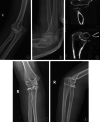Risk Factors of Elbow Stiffness After Open Reduction and Internal Fixation of the Terrible Triad of the Elbow Joint
- PMID: 33619861
- PMCID: PMC7957406
- DOI: 10.1111/os.12879
Risk Factors of Elbow Stiffness After Open Reduction and Internal Fixation of the Terrible Triad of the Elbow Joint
Abstract
Objective: To analyze the risk factors of elbow stiffness following open reduction and internal fixation of the terrible triad of the elbow joint.
Methods: A retrospective study was conducted of 100 patients with the terrible triad of the elbow joint, who had been treated at our hospital from January 2015 to December 2018. All patients were treated with a loop plate to repair the ulnar coronoid process. According to the severity of the injury, the radial head was either fixed or replaced, and the lateral collateral ligament was repaired with an anchor. According to the range of motion of the elbow during the last follow-up, the patients were divided into two groups. The stiffness group (displayed extension-flexion or pronation-supination <100°) consisted of 30 patients. The second group, named the non-stiffness group (exhibited extension-flexion and pronation-supination ≥100°), consisted of 70 patients. Related risk factors included age, gender, smoking, diabetes, whether the fracture is on the dominant side, mechanism of injury, fracture classification, time from injury to surgery, configuration of internal fixation of the radial head, postoperative immobilization time, and use of anti-heterotopic ossification drugs (oral indomethacin). Both t-test and chi squared test were used to analyze any significant differences. Only the variables with a P < 0.05 in the tests were retested into a logistic multiple regression in order to screen risk factors of elbow stiffness.
Results: All patients were followed up for 12-48 months (average, 25.7 months), and all patients exhibited bone healing. Multivariate regression analysis showed that high-energy injury (OR = 3.068, 95% CI 1.134-8.295, P = 0.027), time from injury to surgery > 1 week (OR = 2.714, 95% CI 1.029-7.159, P = 0.044), and postoperative immobilization time (OR = 3.237, 95% CI 1.176-8.908, P = 0.023) were independent risk factors of elbow stiffness after surgery for the terrible triad of the elbow.
Conclusion: High-energy injury, the time from injury to surgery > 1 week, and postoperative joint immobilization time > 2 weeks are the independent risk factors of elbow stiffness after surgery of the terrible triad of the elbow, which should be treated carefully in clinical treatment.
Keywords: Elbow stiffness; Internal fixation; Risk factors; The terrible triad of the elbow.
© 2021 The Authors. Orthopaedic Surgery published by Chinese Orthopaedic Association and John Wiley & Sons Australia, Ltd.
Figures

References
-
- Hotchkiss RN, Green DP, Bucholz JD, et al. Fractures and dislocations of the elbow//Rockwood CA. In: Rockwood and Green's Fractures in Adults, 4th edn. Philadelphia: Lippincott‐Raven, 1996; 929–1024.
-
- Regan W, Morry B. Fractures of the coronoid process of ulna. J Bone Joint Surg, 1989, 71: 929–1024. - PubMed
-
- Hotchkiss RN. Displaced fractures of the radial head: internal fxation or excision. J Am Acad Orthop Surg, 1997, 5: 1–10. - PubMed
MeSH terms
Grants and funding
LinkOut - more resources
Full Text Sources
Other Literature Sources
Medical

